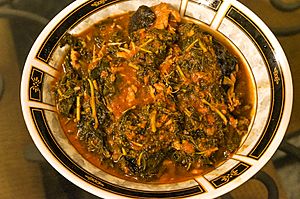Catfish stew facts for kids

Nigeria catfish stew
|
|
| Type | Stew |
|---|---|
| Place of origin | United States |
| Region or state | Southern United States |
| Main ingredients | Catfish, tomatoes, potatoes, and onions, Hot sauce or Tabasco sauce |
Catfish stew is a warm and hearty dish often enjoyed in the Southern United States. It's especially popular in states like South Carolina. This stew is made with catfish, which is a type of freshwater fish. The fish is cooked until it's very tender and falls apart easily.
The main ingredients in catfish stew are usually catfish, tomatoes, potatoes, and onions. Sometimes, people add hot sauce or Tabasco sauce to give it a spicy kick! It's a comforting meal, especially on a cool day.
Contents
What is Catfish Stew?
Catfish stew is a thick, flavorful soup or stew. It's known for its rich taste and the way the fish blends with the vegetables. The fish used is usually from the sides of the catfish. This part of the fish is best for stewing because it becomes very soft.
The stew often has a reddish color from the tomatoes. However, some versions, called "white catfish stew," don't use tomatoes. Instead, they might add milk, making the stew creamy and lighter in color. This white version is less common but still a tasty option.
Where Does Catfish Stew Come From?
Catfish stew has deep roots in the Southern United States. It's a traditional dish that has been enjoyed for many years. People in the South have long relied on local ingredients, and catfish are plentiful in the rivers and lakes there. This made catfish a natural choice for a hearty meal.
The exact origin of the stew is not fully known. However, it's clear that it became a staple in Southern kitchens. Families would often gather to enjoy this simple yet delicious dish. It reflects the cooking traditions of the region, which often use fresh, local produce and meats.
How Is Catfish Stew Made?
Making catfish stew involves a few key steps. First, the catfish fillets are boiled until they are very soft. This helps the fish break apart easily. After the fish is cooked, it's usually flaked or shredded.
Next, other ingredients are added. These include crushed tomatoes, diced potatoes, and chopped onions. These vegetables are cooked until they are tender. All the ingredients are then simmered together. This allows the flavors to mix and create a rich stew. Many people also add seasonings like salt, pepper, and, of course, hot sauce for extra flavor.
Key Ingredients for Catfish Stew
- Catfish: The main star of the stew. It's boiled until it's very tender.
- Tomatoes: Often crushed tomatoes are used, giving the stew its classic color and tangy flavor.
- Potatoes: These add substance and help thicken the stew.
- Onions: They provide a savory base flavor.
- Hot Sauce: Many people love to add a dash of Hot sauce or Tabasco sauce for a spicy kick.
Different Styles of Catfish Stew
While the classic catfish stew is made with tomatoes, there are some variations. The most notable is "white catfish stew." This version leaves out the tomatoes. Instead, it might include milk or cream. This gives the stew a lighter color and a different, often milder, flavor.
Even within the tomato-based stews, there can be differences. Some recipes might include other vegetables like corn or bell peppers. The amount of spice can also vary greatly, from mild to very hot. Each family or region might have its own special way of making this beloved dish.
Why Catfish Stew is Popular
Catfish stew is popular for several reasons. It's a comforting and filling meal, perfect for feeding a family. The ingredients are often affordable and readily available in the Southern United States. It's also a dish that brings people together.
Many people have fond memories of eating catfish stew growing up. It's a taste of home and a part of Southern culinary heritage. Its simple yet satisfying nature makes it a timeless favorite.

